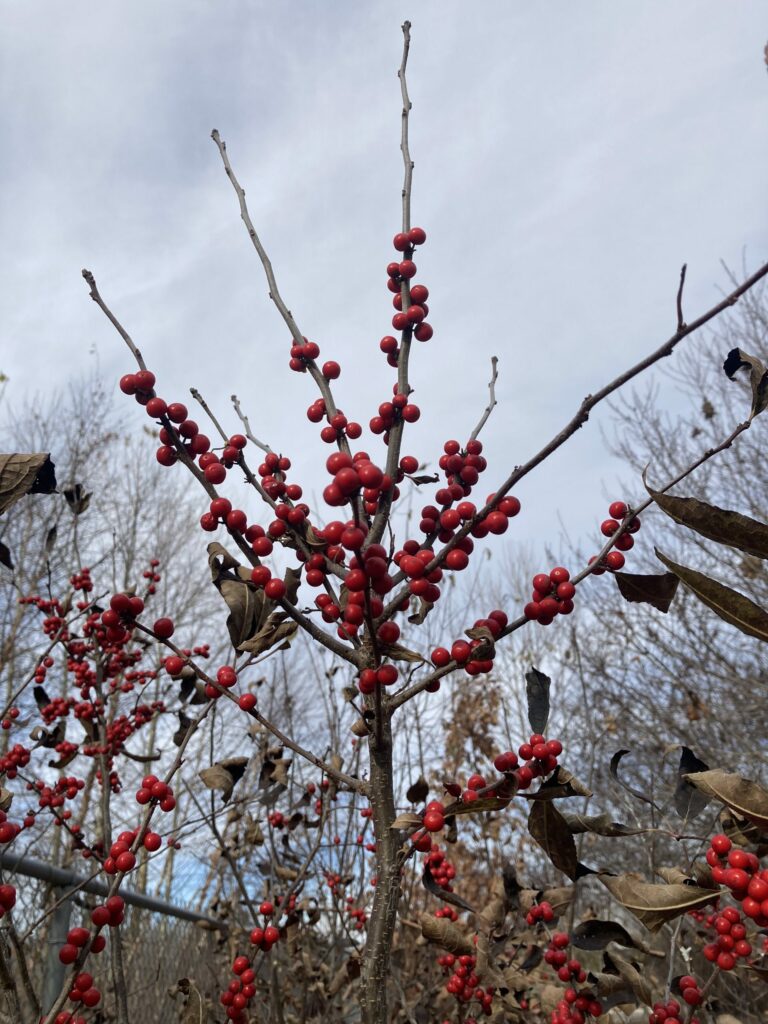By: Mark Halpin, Forestry Manager
Fall color has finally departed, and the few leaves that remain clinging to the trees are for the most part withered and pale, and so we enter that time of the year when for many people the natural world fades from awareness. This is a shame, because even to the casual observer there is much to see in the winter landscape – the exposed red and yellow stems of dogwood shrubs, the fascinating bark textures and branching habits of trees and shrubs, and most eye-catching of all, winter fruit. And no fruit is more emblematic of winter than those of the holly.
The evergreen hollies, represented by Ilex opaca in North America, which closely resembles Ilex aquifolium, the true “Christmas holly” of European descent, may be one of the great icons of winter. But for fruit display, none of these plants can touch Ilex verticillata, whose common name is appropriately “winterberry”. A deciduous holly, it bears its fruit on naked branches sheathed in silvery-grey bark. Seen against a backdrop of snow on a cold day, the luscious wine-red color of the berries positively warms the blood like a crackling fire and a mug of piping hot chocolate. Luscious though they may look, these berries are somewhat toxic to humans, but a valuable winter food source for eastern bluebirds, American robins, northern mockingbirds, and cedar waxwings, among others. So leave them be, and let the birds have them. Maybe take just a couple branches for a wreath.
Winterberry holly in exceptional cases can reach 15 feet tall with a tree-like form, but is more often a smaller shrub-form plant. A multitude of cultivars have emerged over the years, most of which will remain under 3’ in height and spread. Like all hollies, winterberry is dioecious – male and female sex organs exist on separate plants – meaning you’ll need a ‘Southern Gentleman’ or ‘Jim Dandy’ around to service your ‘Red Sprite’ or ‘Berry Heavy’ cultivar to ensure she produces berries (if you prefer a straight-species, pure native winterberry and still want to ensure fruit set, you can either compromise and purchase a male cultivar, or you’ll have to inspect plants during flowering to determine their sex). The typical design scheme is to place one male in the back of a group of up to 10 females. Occasionally, in an act of horticultural sleight-of-hand, a male branch will be grafted onto a female plant, eliminating the need for a separate plant entirely. Until someone accidentally prunes the male branch off…
During the growing season, Ilex verticillata isn’t a showstopper. It’s just a green, nondescript plant. The berries are the real ornamental payoff, but winterberry has another trait that helps make up for its summertime anonymity; it is extremely adaptable, and particularly tolerant of poorly draining urban soils, being a plant that naturally grows in swamps. If you have a low spot in your yard and don’t want to plant a larger tree there, a grouping of winterberry might be a good choice for water mitigation. It can also tolerate dry soil, and quite a bit of shade, but the best fruit set will be in moist conditions with partial to full sun.
Don’t let the falling temperatures cut you off from the natural world – go out and look for a winterberry holly, or just go out in search of nothing in particular. There is plenty of beauty in the winter landscape. Invest in some good clothes, maybe a nice vacuum flask (what you choose to put in it is none of my business), and enjoy. In a land where mosquitoes, ticks and chiggers can make the summer unbearable at times, winter can almost seem like a relief after months of itching and scratching. Stay warm, and stay curious.




